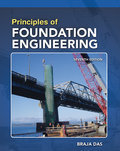
Originally published in the fall of 1983, Braja M. Das' Seventh Edition of PRINCIPLES OF FOUNDATION ENGINEERING continues to maintain the careful balance of current research and practical field applications that has made it the leading text in foundation engineering courses. Featuring a wealth of worked-out examples and figures that help students with theory and problem-solving skills, the book introduces civil engineering students to the fundamental concepts andapplication of foundation analysis design. Throughout, Das emphasizes the judgment needed to properly apply the theories and analysis to the evaluation of soils and foundation design as well as the need for field experience. INDICE: 1. GEOTECHNICAL PROPERTIES OF SOIL. Introduction. Grain-Size Distribution. Size Limits for Soils. Weight-Volume Relationships. Relative Density.Atterberg Limits. Liquidity Index. Activity. Soil Classification Systems. Hydraulic Conductivity. Steady-State Seepage. Effective Stress. Consolidation. Calculation of Primary Consolidation Settlement. Time Rate of Consolidation. Degree of Consolidation Under Ramp Loading. Shear Strength. Unconfined Compression Test. Comments on Friction Angle, f'.Correlations for Undrained Shear Strength, cu . Sensitivity. Problems. References. 2. NATURAL SOIL DEPOSITS AND SUBSOIL EXPLORATION. Introduction. Natural Soil Deposits: Soil Origin. Residual Soil. Gravity Transported Soil. Alluvial Deposits. Lacustrine Deposits. Glacial Deposits. Aeolian Soil Deposits. Organic Soil. Some Local Terms for Soils. Subsurface Exploration: Purpose of Subsurface Exploration. Subsurface Exploration Program. Exploratory Borings in the Field. Procedures for Sampling Soil. Split-Spoon Sampling. Sampling with a Scrapper Bucket. Sampling with Thin-Walled Table. Sampling with a Piston Sampler. Observation of Water Tables. Vane Shear Test. Cone Penetration Test. Pressuremeter Test (PMT). Dilatometer Test. Coringof Rocks. Preparation of Boring Logs. Geophysical Exploration. Subsoil Exploration Report. Problems. References. 3. SHALLOW FOUNDATIONS: ULTIMATE BEARING CAPACITY. Introduction. General Concept. Terzaghi's Bearing Capacity Theory. Factor of Safety. Modification of Bearing Capacity Equations for Water Table. The General Bearing Capacity Equation. Case Studies on Ultimate Bearing Capacity. Effect of Soil Compressibility. Eccentrically Loaded Foundations. Ultimate Bearing Capacity under Eccentric Loading - One-Way Eccentricity. Bearing Capacity with Two-Way Eccentricity. Bearing Capacity of a Continuous Foundation Subjected to Eccentric Inclined Loading. Problems. References. 4. ULTIMATE BEARING CAPACITY OF SHALLOW FOUNDATIONS: SPECIAL CASES. Introduction. Foundation Supported by a Soil with a Rigid Base at Shallow Depth. Bearing Capacity of Layered Soils: Stronger Soil Underlain by Weaker Soil. Bearing Capacity of Layered Soil: Weaker Soil Underlain by Stronger Soil. Closely Spaced Foundations - Effect on Ultimate Bearing Capacity. Bearing Capacity of Foundations on Top of aSlope. Seismic Bearing Capacity of Foundation at the Edge of Granular Soil Slope. Bearing Capacity of Foundations on a Slope. Foundations on a Rock. UpliftCapacity Foundations. Problems. References. 5. SHALLOW FOUNDATIONS: ALLOWABLEBEARING CAPACITY AND SETTLEMENT. Introduction. Vertical Stress Increase in a Soil Mass Caused by Foundation Load: Stress Due to a Concentrated Load. StressDue to a Circularly Loaded Area. Stress Below a Rectangular Area. Average Vertical Stress Increase Due to a Rectangularly Loaded Area. Stress Increase under an Embankment. Westergaard's Solution for Vertical Stress Due to a Point Load. Stress Distribution for Westergaard Material. Elastic Settlement: Elastic Settlement of Foundations on Saturated Clay. Settlement Based on the Theory of Elasticity. Improved Equation for Elastic Settlement. Settlement of Sandy Soil: Use of Strain Influence Factor. Settlement of Foundation on Sand Based on Standard Penetration Resistance. Settlement in Granular Soil Based on Pressuremeter Test (PMT). Consolidation Settlement: Primary Consolidation Settlement Relationships. Three-Dimensional Effect on Primary Consolidation Settlement. Settlement Due to Secondary Consolidation. Field Load Test. Presumptive Bearing Capacity. Tolerable Settlement of Buildings. Problems. References. 6. MAT FOUNDATIONS. Introduction. Combined Footings. Common Types of Mat Foundations. Bearing Capacity of Mat Foundations. Differential Settlement of Mats. Field Settlement Observations for Mat Foundations. Compensated Foundation. Structural Design of Mat Foundations. Problems. References. 7. LATERAL EARTH PRESSURE. Introduction. Lateral Earth Pressure at Rest. Active Pressure: Rankine Active Earth Pressure. A Generalized Case for Rankine Active Pressure. Coulomb's Active Earth Pressure. Active Earth Pressure Due to Surcharge. Active Earth Pressure for Earthquake Conditions. Active Pressure for Wall Rotation about the Top: BracedCut. Active Earth Pressure for Translation of Retaining Wall - Granular Backfill. Passive Pressure: Rankine Passive Earth Pressure. Rankine Passive Earth Pressure: Vertical Backfill and Inclined Backfill. Coulomb's Passive Earth Pressure. Comments on the Failure Surface Assumption for Coulomb's Pressure Calculations. Passive Pressure Under Earthquake Conditions. Problems. References. 8. RETAINING WALLS. Introduction. Gravity and Cantilever Walls: Proportioning Retaining Walls. Application of Lateral Earth Pressure Theories to Design. Stability of Retaining Walls. Check for Overturning. Check for Sliding along the Base. Check for Bearing Capacity Failure. Construction Joints and Drainage fromBackfill. Gravity Retaining Wall Design for Earthquake Conditions. Some Comments and a Case Study on Design of Retaining Walls. Mechanically Stabilized Retaining Walls: Soil Reinforcement. Considerations in Soil Reinforcement. General Design Considerations. Retaining Walls with Metallic Strip Reinforcement. Step-by-Step-Design Procedure Using Metallic Strip Reinforcement. Retaining Walls with Geotextile Reinforcement. Retaining Walls with Geogrid Reinforcement -General. Design Procedure for Geogrid - Reinforced Retaining Wall. Problems.References. 9. SHEET PILE WALLS. Introduction. Construction Methods. Cantilever Sheet Pile Walls. Cantilever Sheet Piling Penetrating Sandy Soils. Special Cases for Cantilever Walls Penetrating a Sandy Soil. Cantilever Sheet Piling Penetrating Clay. Special Cases for Cantilever Walls Penetrating Clay. AnchoredSheet-Pile Walls. Free Earth Support Method for Penetration of Sandy Soil. Design Charts for Free Earth Support Method (Penet
- ISBN: 978-0-495-66812-1
- Editorial: Nelson Canada
- Encuadernacion: Rústica
- Páginas: 750
- Fecha Publicación: 20/05/2010
- Nº Volúmenes: 1
- Idioma: Inglés
